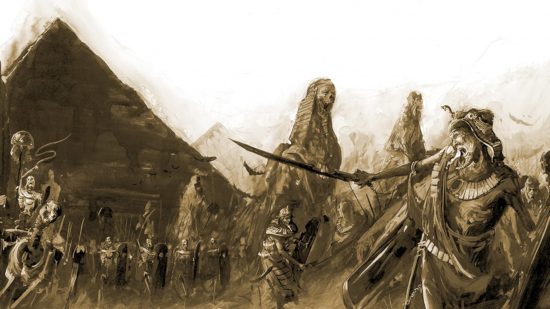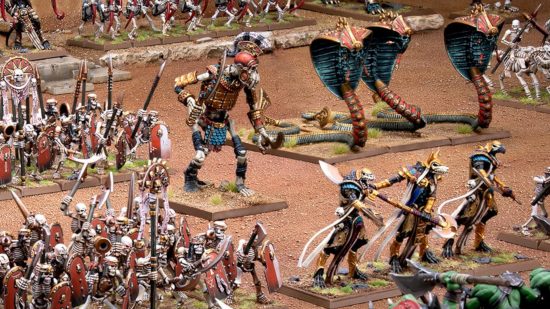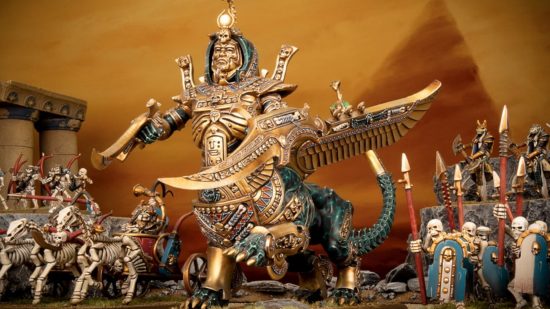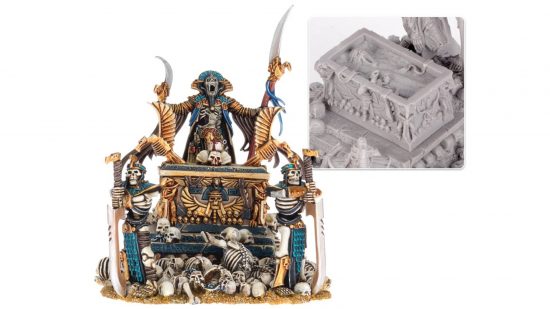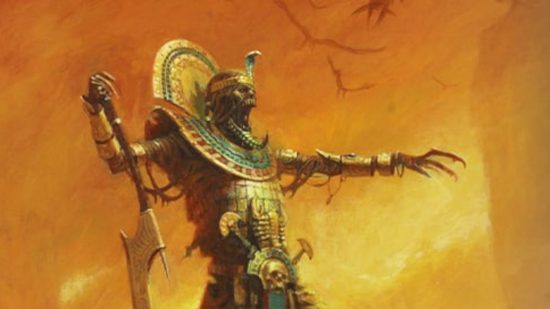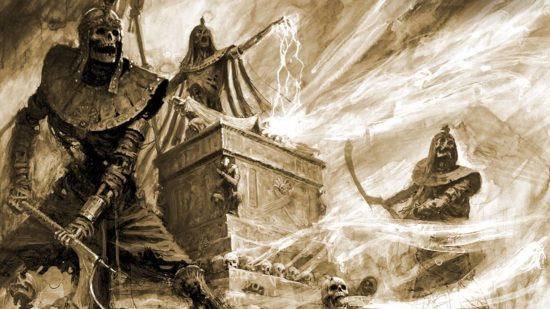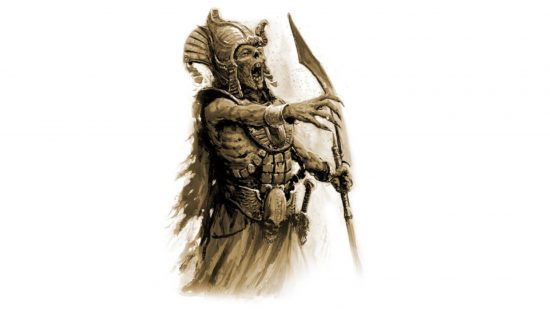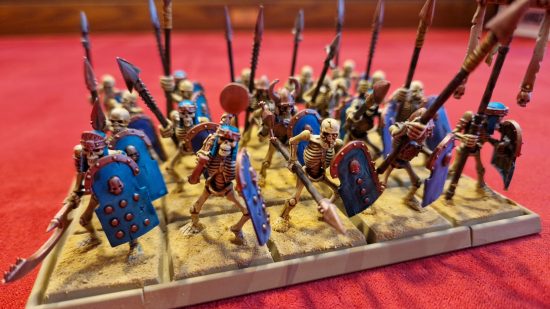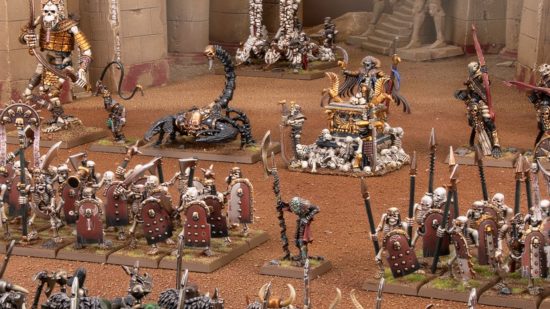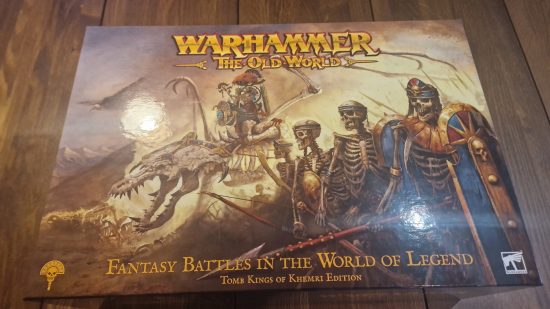In Warhammer, Tomb Kings are an iconic, Ancient Egypt-themed undead faction dating back to 2003, and the Sixth Edition of Games Workshop’s Warhammer Fantasy Battle game. Now, with Warhammer The Old World, they’ve risen once again from the sands of Nehekhara to reclaim their lost kingdoms. This guide covers everything you need to know about the Tomb Kings of Khemri, from ancient lore to brand new rules.
For a more general grounding in GW’s new old fantasy miniature wargame, try our guides to the Warhammer The Old World rules, and all the playable Warhammer The Old World factions. Alternatively, see where they are in the ‘new’ world with our full guide to all the Age of Sigmar armies. For now, though…
Explore our Warhammer The Old World Tomb Kings guide:
Who are the Tomb Kings?
In Warhammer The Old World, the venerable Tomb Kings are a proud, expansionist, undead faction, hailing from the desert lands in the far south of the map, described in GW’s 2024 ‘Arcane Journal – Tomb Kings’ supplement as “The Land of the Dead… a landscape cursed by the nefarious machinations of the dread Necromancer Nagash”.
The Tomb Kings were originally known as the Kingdom of Nehekhara – among the very first great human empires in the Warhammer world, and a very clear analog for the real-world ancient Egyptian empire.
They built great pyramids; lived in an equatorial country split between scorching desert and fertile floodplains; revered and ritualized death and the afterlife via a mystic, priestly class; favored war chariots, colorful head-dresses, and khopesh swords, et cetera. You get it, these guys are fantasy Egyptians.
The living and the dead
But this is Warhammer – so we need to add magic into the mix. The Nehekharans’ religious body – the Mortuary Cult – wasn’t just fascinated with death; it developed its own magics to weaponize unlife, turning inanimate objects like statues and monuments of stone and metal into mighty, walking weapons of war.
The Arcane Journal supplement tells us that, as the Nehekharan civilization grew, the Cult delved deeper into necromancy, expanding their armies to include not only these terrifying war constructs – but cohorts of living dead skeleton warriors, fighting alongside the regular, alive soldiers.
Thus, even in ancient times – centuries before the period in which The Old World is set – Nehekhara’s greatest kings and heroes went to war at the head of armies of both the living and the dead.
Nagash and the Great Ritual
These days, however, things are a little different. Many centuries after Nehekhara’s golden age, when all its mightiest leaders, cities, and armies were dead, mummified, and swallowed by the shifting sands, a young prince of Khemri named Nagash rose to prominence within the necromantic orders of the Mortuary Cult.
Bent on ruling Nehekhara (and thereafter the world) he murdered his brother, the King, and stole the throne – but was later deposed again by an alliance of rebellious Nehekharan nobles. Unable to hold on to power, Nagash retaliated by enacting a huge necromantic ritual which instantly destroyed all living things in Nehekhara – and resurrected them again to eternal, undead life.
It wasn’t only the Nehekharans Nagash had just murdered that rose back to life, however – but all of them: tens of thousands of long-dead kings, priests, wizards, soldiers, horses and war-steeds – everyone was brought back in angry, sandy, skeletal form.
Well, technically, they’re not all skeletal; the most senior members of ancient Nehekharan society, and especially the Kings and Princes, were ritually mummified to preserve their living bodies for their eventual resurrection to glory.
This didn’t go to plan, because Nagash’s black magic set off their royal alarm clocks early. But, as we know from the real world, mummification works a treat, and so – though the Tomb Kings’ soldiers and horses may be nothing but dry, sun-bleached bones – the royalty still boast varying amounts of intact (if desiccated and shrivelled) flesh. Lucky them!
These, then, are the Tomb Kings as we meet them in Warhammer The Old World: a collection of proud, warlike, constantly competing, undead dynasties, united by their bitterness, arrogance, and determination to conquer. Led by their last and greatest monarch – the fearsome and many-titled Settra the Imperishable – they are currently launching a huge offensive against the Border Princes, a patchwork of small states on Bretonnia‘s southern fringe.
Tomb Kings models and units
Hobbyists used to the massive rosters of the modern Warhammer 40k factions – and some of the Age of Sigmar armies – might be surprised to find the range of Tomb Kings models more modest in size, despite this army’s place of honor among the classic Warhammer factions.
The full roster – which you’ll find in The Old World Ravening Hordes army book – includes 23 units, composed of four character units; seven infantry units; four cavalry units; one chariot unit; five monster units (four of them behemoths); and two war machines:
| Unit type | Unit name |
| Character | Monarchs of Nehekhara |
| Character | Royal Herald |
| Character | Liche Priest |
| Character | Necrotect |
| Infantry | Tomb Guard |
| Infantry | Skeleton Warriors |
| Infantry | Skeleton Archers |
| Infantry | Skeleton Skirmishers |
| Infantry | Ushabti |
| Infantry | Tomb Swarms |
| Infantry | Carrion |
| Cavalry | Skeleton Horsemen / Horse Archers |
| Cavalry | Necropolis Knights / Sepulchral Stalkers |
| Chariot | Skeleton Chariots |
| Monster | Necrolith Bone Dragon |
| Monster | Khemrian Warsphinx |
| Monster | Tomb Scorpion |
| Monster | Necrolith Colossus |
| Monster | Necrosphinx |
| War Machine | Screaming Skull Catapult |
| War Machine | Casket of Souls |
We’ll go over each unit briefly in turn, explaining its role, strengths, and weaknesses.
Monarchs of Nehekhara
The Monarchs of Nehekhara are the titular Tomb Kings and Tomb Princes – aristocratic leaders of the ancient Nehekharan empire who maintain their unquestioned right to rule, even as undead revenants.
These are your main commander unit, benefiting from a high Leadership stat and the crucial My Will Be Done ability, which gives the character, its mount, and any unit it’s attached to your choice of three useful stat buffs, depending on your situation.
The Tomb King variant is best, with an extra pip in Weapon Skill, Strength, Wounds, Initiative, Attacks, and Leadership compared to the Prince, as well as the ability to equip Heavy Armor and access to twice as many points’ worth of magic items – but he pays dearly for it, costing 160 points to the Prince’s 90.
Royal Herald
Bodyguards and standard bearers for your Tomb Kings and Princes, the Royal Herald is a support character who’s essentially just there to stand within three inches of your Monarch of Nehekhara, use its Sworn Protector rule to take wounds on their behalf, and thus keep your commander alive longer.
Liche Priest
The classic Tomb Kings wizards, Liche Priests are adepts of the Mortuary Cult – the “keepers of Nehekhara’s arcane lore”, according to Ravening Hordes – and an essential part of the tabletop army.
They come in two flavors: the weaker, cheaper Mortuary Priest (Wizard level 1-2), and the more expensive, full-fat High Priest (Wizard level 3-4).
For a variety of reasons, the Tomb Kings are highly reliant on their powerful death magic to win battles – and Liche Priests are your only Wizard unit, so you don’t want to leave home without at least one.
In fact, you’re literally not allowed to – the Tomb Kings’ The Hierophant rule means your army list must include at least one Liche Priest to be its ‘Hierophant’ (read: chief magic guy) and that, should the Hierophant die, your undead units will lose their usual access to the Regeneration rule for the remainder of the battle – very bad news.
Unsurprisingly, then, you’ll usually be fielding at least two of these guys, both to maximize your access to spells from the three Lores of Magic available to you, and to get the most use out of the Liche Priests’ two core abilities: Arise – which returns lost models and wounds to damaged units; and From Beneath the Sands – which magically summons units from reserves anywhere on the board.
Necrotect
In life, the Necrotects were Nehekhara’s cadre of genius architects and civil engineers, who designed, oversaw, and maintained the country’s vast monuments, cities, and necropolises.
In undeath, they’re junior leaders and taskmasters of the Tomb Kings’ skeleton armies, keeping the legions to task on behalf of their noble masters.
In games of The Old World, these guys are force multiplier characters to tack onto your favorite infantry units, and not much else – their Eternal Taskmaster ability lets them give your skellies a useful turn-long buff including an extra attack and the Hatred special rule.
Tomb Guard
You know how ancient Egyptian Pharaohs’ foremost warriors would be buried in full arms and armor inside their monarchs’ tombs, ready to protect them in the afterlife? That’s what the Tomb Guard are – the Nehekharan royals’ elite troops, armed to the teeth and clad in ceremonial golden bling.
In-game, these guys are your closest thing to decent regular infantry (spoilers – your regular bog standard skellies are pretty weak and terrible).
Skeleton Warriors
The basic building block of the Tomb Kings army, Skeleton Warriors represent the numberless legions of long-dead Nehekharan soldiers returned to unlife to fight for their liege lords. Their honorable service brings a tear to the eye.
Unfortunately, their battlefield effectiveness is also enough to make one weep. These folks were not elite fighters back when they were alive, and centuries asleep in the infinite void have not improved their martial skill (or the quality of their tattered cloth armor and rusted weapons).
In game, these units are fragile, weak, and slow – but also very, very cheap, at a mere four points per model. Their shields improve their armor save roll from 7+ to 6+, and you can get it up to a 5+ by paying points for light armor, but ultimately their regular hand weapons aren’t going to do an awful lot of killing, so they’re usually going to be more useful in large numbers.
You’ll want to field them in several big hordes, and use them to ‘tar-pit’ your opponent, keeping their frontline occupied while your damage-dealing units get in position on the flanks, to hit them where it hurts.
Ushabti
Speaking of damage-dealers, the iconic Ushabti are the OG, the coolest Tomb Kings unit of all time as proven by science. They are magically animated statues of the ancient, animal-headed Nehekharan gods, who normally stand sentinel over temples and tomb complexes, but come to necromantic life and march alongside Tomb Kings armies in war.
Classified as Monstrous Infantry with at least three models to a unit (but, interestingly, no maximum model count), these are your elite infantry heavy-hitters. They come armed with either huge, heavy Ritual Blades – which always strike last in combat but hit like a truck with high armor-piercing stats – or ponderous Greatbows – which won’t fire many shots, but mince armor and deal double wounds when they hit.
Both loadouts have their uses, depending on what strategy your list is built around – and both flavors of Ushabti will be a non-trivial threat with which to bully your opponent’s high value units.
Skeleton Archers
Skeleton Archers are skeletons with bows – your regular shooting infantry, boasting exactly the same stat line as your Skeleton Warriors, but swapping the shield for a Warbow that can fire over a 24-inch range.
Unless you pay points for light armor, these skellies have a 7+ armor save (in most cases, no save at all) – so if you let the enemy engage them hand to hand, they’ll very quickly become a sorry pile of bone fragments.
But, in sufficient numbers, well placed on a hill, kept stationary and out of harm’s way, Skeleton Archers will be a very important tool for harrying enemies that get close to your frontline with volley fire – especially considering the Tomb Kings’ Arrows of Asaph special rule, which makes the army’s ranged units immune to modifiers that’d otherwise debuff their hit chances.
Skeleton Skirmishers
Skeleton Skirmishers are cheap, vulnerable, multi-purpose fighters with the same basic skeleton statline, but no shield or armor or bows by default, just their bony selves and basic hand weapons.
Their main deal is – as per their name – having the Skirmishers special rule, which lets them adopt Skirmish formation rather than the standard, rank-and-file Closed Order most units use. This lets them spread out into a loose, one-inch-spaced blob (much like units in Warhammer 40k or Age of Sigmar); imparts a -1 to hit on enemy units trying to shoot them; and allows them to shoot ranged weapons in any direction, rather than in set arcs like Archers.
Their Chariot Runners rule also allows them to crowd around your chariots, protecting them from charges to the flank or rear, without blocking the chariots from moving, charging, or otherwise going about their awesome, wheely business.
Got some chariots that need keeping alive, or simply spare points you don’t know what to do with? Maybe take along some Skeleton Skirmishers to annoy, confuse, or (very briefly) screen off enemy charges.
Tomb Swarms
The Ravening Hordes army book charmingly describes Tomb Swarms as “the dried husks of scorpions, scarabs, and countless other poisonous creatures of the desert”, dragged into angry unlife by the sorcerous aura of the Tomb Kings’ presence.
In-game, they’re another Skirmisher option – and you can pay an extra two points per model to make them Ambushers, too, so you can bring them on from the sides of the board as reinforcements mid-game. They’re weak, with a Strength of just 2 – but it doesn’t matter much, because their Poisoned Attacks special rule means a roll of a 6 to hit automatically wounds.
With five wounds per model and minimum two models in a unit, they won’t be too easy to shift right away, either. Used in the right way, these buggy boys could be a handy way to harrass and distract enemy assaults.
Carrion
Does your opponent have some annoyingly effective ranged units hiding behind their lines, flinging death at you from afar? Send some Carrion birds to fly right over the battle, swoop down, and rake ’em with their talons.
These gigantic, undead desert birds love nothing more than chewing on dead flesh – but they’ll take live if you insist. With only two wounds apiece, they’re not very durable, but at T4, they’re at least a little bit tougher than a skeleton. More importantly, though, they’re fast, with a 10-inch fly move and Swiftstride, which gives them an extra three inches to charge range and +d6 to charge rolls to boot.
Skeleton Horsemen / Horse Archers
Your regular cavalry units, Skeleton Horsemen and Skeleton Horse Archers are exactly what their names suggest: regular skeleton warriors and archers mounted on cute little bony ponies.
The Horsemen units fight in Close Order, and you can spend points to give them Cavalry Spears (+1 strength on the attack, and the second rank can fight) and/or the Counter Charge special rule, which lets them turn and ride face-on into another cavalry unit that’s trying to charge them, instead of being struck in the flank.
The Horse Archers, on the other hand, are Skirmishers, and can pay points to become Chariot Runners, allowing them to ride shotgun on your crucial, classic Tomb Kings chariot assaults.
Both flavors of bony pony units get an eight inch move and Swiftstride – which is great for mobility – and, in a fight, the front rank get one extra attack per model with their horses’ Skeletal Hooves, too – which is precious.
Necropolis Knights / Sepulchral Stalkers
OK, now we’re getting into the weird stuff. Necropolis Knights are kind of like your regular skeleton cavalry, except instead of ordinary skeleton warriors, their riders are armored elites akin to the Tomb Guard, with Strength and Toughness stats of 4 – and, instead of sitting on skeletal horses, they’re riding gigantic, magically animated cobra statues.
With a seven-inch move and Swiftstride, they’re a little slower than the ponies, and five times more expensive per model. But they make up for it by packing a serious punch, hitting at S5 with their cavalry spears and benefitting from a whole paragraph of special rules to make every attack deadlier.
The Sepulchral Stalkers variant are even odder – they’re similar Necroserpent constructs, but instead of having cavalry riders, they act as standalone, sneaky ambush killers, pairing a scary number of AP -1 attacks with a bizarre, 18-inch range Petrifying Gaze magic attack that turns enemies into pillars of sand. Gnarly.
Skeleton Chariots
What would an army of undead fantasy Egyptians be without its glorious squadrons of Skeleton Chariots? These iconic, wheeled war platforms are among the most iconic Tomb Kings miniatures, and with good reason; as Ravening Hordes says: “the pride of a Tomb Kings army is their chariots”.
On the tabletop, these are your ultimate fast-moving shock assault units. With an eight-inch move and Swiftstride, they can roll out fast, get in position for a tasty target, then make lengthy charges before crashing into the unfortunate enemy and dealing an automatic D3 Impact Hits – before they even lay in with the cavalry spears and extra hoof attacks.
You can also outfit them with bows instead, and have them be roving, fairly mid shooting platforms – if you hate fun.
The most important thing about the Tomb Kings’ light chariots, though, is that they’re unusually cheap at 43 points a pop – you’ll almost always be able to field more than your opponent, and get off more chariot charges, for more impact hits.
Necrolith Bone Dragon
It’s time for the big boy – the brand new, centerpiece model in Games Workshop’s Tomb Kings launch box set is the magnificent, ten-inch-long, six-inch-tall Necrolith Bone Dragon.
Ravening Hordes tells us that, like the Tomb Kings’ horses and soldiers, these great drakes were once flesh and blood – winged behemoths that “dwelled within the mountains to the East of Nehekhara” – and that, in the civilization’s ancient days, “many were captured and bound to the will of human masters”.
Nagash’s magical mischief brought the remains of these mighty beasts back to life in skeletal form, however. And, after a bit of experimentation by the Tomb Kings’ devious Liche Priests, they’ve now been drafted back into service as colossal flying mounts to carry your leaders into battle.
On the tabletop, this guy is a serious terror. Ridden by a Tomb King, Prince, or Liche Priest, the dragon gives your character an extra five wounds, an extra pip of Toughness, and a best-in-game 4+ armor save from its Draconic Bones – not to mention a nine-inch flying move with Swiftstride on top.
At range, it can use its Breath of Desiccation to spray out S3, AP-2, two-wound attacks over a big long flame template. Once you charge into melee, it inflicts Terror, before throwing out five S6, AP-2 attacks with its Wicked Claws, plus D6 extra Stomp Attacks because it’s such a big lad.
Still not impressed? The Bone Dragon enjoys the protection of a Cloud of Dust, giving enemies a permanent -1 to hit it with shooting attacks. If you want your prize character to be a highly dangerous, mobile flying fortress, stick them on a Bone Dragon – just be aware it’s pricey at 195 points.
Khemrian Warsphinx
The second Tomb Kings Behemoth unit – which can also be a character mount – is the noble Khemrian Warsphinx. Imagine Hannibal’s famous war elephants – giant, lumbering beasts topped with howdah platforms crewed by elite warriors – but swap out the elephants for ornate, roaring, lion-bodied sphinx statues of ensorcelled stone.
These constructs were made as guardians of the vast underground tomb complexes under the Nehekharan pyramids – but they’re drafted into battle as impervious war platforms, and crewed by Tomb Guards armed with both cavalry spears and shortbows.
At Toughness 6, five wounds, and a 5+ save, the Warsphinx is a little less survivable than the Bone Dragon – and, with no wings, it moves a relatively meager six inches. Fully kitted out with upgrades (an extra two Tomb Guard crew, an Envenomed Sting, and a Fiery Roar breath attack) it rivals the dragon for offensive power, making for a pretty potent choice – but it’ll cost you 210 points.
Tomb Scorpion
The peculiar and terrifying Tomb Scorpions are the Tomb Kings’ most affordable dedicated anti-Monster units. Completely artificial war beasts brought into being by the Mortuary Cult’s magic, these ornate living weapons are described in Ravening Hordes as giant, pincered scorpions “formed from a combination of stone, metal, lacquered wood, and fused bone”.
Relatively fast-moving at seven inches, and able to take the Ambushers special rule for an extra five points per model, they’re a mobile choice – and their Bone Carapace’s 5+ save, paired with Toughness 5, makes them relatively sturdy for a Tomb Kings unit.
Their party trick, though, is four attacks apiece with their S5, AP-2 Decapitating Claws, with both Killing Blow and Monster Slayer rules on top. Those two spicy rules mean that, if you roll a six to wound against an infantry, cavalry, or monster model, that model has to pass a ward save (if it has one) or it just dies, with no other saves allowed.
Against regular blocks of troops, that’s no big deal – they only have one wound each anyway – but send these pinchy pals against a big, nasty, expensive killing machine, and you’ve got a decent chance of taking it out in one go.
Necrolith Colossus
We regret to inform you that the Necrolith Colossus is real and can hurt you. Well, your opponent’s units, anyway.
The third behemoth in the Tomb Kings line-up, they are towering animated warrior statues, clad in ancient heavy armor caked in skulls and bones, and wielding two giant khopesh swords.
At Toughness 6, a 5+ save, and five wounds, they’re very tough – but make no mistake – the Necrolith Colossus is very much an offensive weapon, meant to charge into the thick of the foe and lay waste to them.
To begin with, it gets four attacks at S6, AP-2 plus D3 stomp attacks – already a respectable whack – but the real spice comes from its Unstoppable Assault special rule. This means that, in the turn it charges, every unsaved wound it delivers to the enemy generates an extra attack – and those extra attacks can generate extra attacks.
This is just the kind of monstrous, swingy, devastating dice-driven nonsense we wanted to see from the return of Warhammer Fantasy. Charge a Necrolith Colossus into your enemy’s lines, and if you roll well, you could wipe out half their army at a stroke.
Just be aware that they’re pricey at 160 points, and will immediately become a priority target for all the ranged firepower your opponent can throw at it. Warhammer 40k players will recognize the concept of the Tyranids‘ ‘distraction carnifex’ – and the Tomb Kings’ Colossus operates very similarly.
Necrosphinx
If you thought you’d already met the weirdest things the Tomb Kings had to offer, think again. The abominably beautiful Necrosphinx is an enormous, metallic, magical chimera that’s a bit like the Khemrian Warsphinx (and built from the same model kit) but trades the latter’s crewed war platform for a pair of wings on its back and two massive, scything blades at the front.
In-game, the Necrosphinx is probably the most dangerous unit in your arsenal, and most definitely your best tool to take out enemy behemoths. Its basic statline matches the Khemrian Warsphinx (except for having one additional wound, for six total) – but two other points make it uniquely potent:
- It can fly nine inches a turn
- It’s juiced up for dealing heavy damage to a single monster target.
Its AP-1 Cleaving Blades have one less pip of armor piercing than the Warsphinx’s Wicked Claws, but they make up for it with Killing Strike. That’s beside the point, though – the main event is the Necrosphinx’s signature Decapitating Strike: one attack per turn, Strength 10, AP-4, Killing Blow, and Monster Slayer.
And this is underlined by its Soul Reaper special rule: at the beginning of the game, you’ll name a single enemy character “marked by the Necrosphinx to journey into the underworld” and your Necrosphinx gets to re-roll hit rolls of 1 against that target for the whole game.
Proclaiming “vendetta!” in a silly faux-Italian accent when you do this is optional, but recommended.
Screaming Skull Catapult
The Tomb Kings’ only ranged siege weapon, the Screaming Skull Catapult is aptly named, as it’s not only an onager catapult partly made of skulls, but also uses them as ammunition. Great clusters of cursed, flaming, magical skulls, to be precise.
Following the rules for a stone thrower, this is a bombardment weapon – so you’ll target a point with a three-inch round blast template, then roll the scatter dice to see where your projectile hits.
Any models in the central hole of the template are hit for Strength 8, AP-3, while models in the rest of the template take S4 AP-1. That’s pretty heavy, but the real fun comes with the Screaming Skull Catapult’s morale-damaging powers.
If an enemy unit takes one or more wounds from the falling skulls, it has to take a Panic test as if it had taken heavy casualties – and, if you paid the extra 20 points to make them the Skulls of the Foe, all enemy units within 2D6 inches of the centre of the template get -1 to Leadership until your next turn.
Roll well with your catapult attacks, and you can damage and disrupt your enemy’s formations before they even get close – a critical advantage for the Tomb Kings, whose flimsy skeleton frontlines will perform poorly if the enemy is still in good order when it reaches them.
Casket of Souls
The final unit on the Tomb Kings roster, the Casket of Souls, is the Ark of the Covenant. OK, so not exactly – it’s a chest filled with the rageful, imprisoned souls of a Tomb King’s defeated enemies – but functionally it’s very similar.
A stationary unit that practically can’t move at all, the Casket acts as a magical locus that grants your Liche Priests within 12 inches a +1 to casting rolls, and can itself cast one of two Bound spells. These are:
- Light of Protection – a handy, lasting enchantment that grants itself, and every Tomb Kings unit within 18 inches, a 6+ ward save and -1 to hit from shooting.
- Light of Death – a gnarly, 36-inch range magic missile that deals a horrifying D6+3, Strength 6, two-wound hits that can’t be saved except via Ward saves (so long as the target fails a Leadership test). If they pass leadership, it does a paltry D3 S3, AP-1 hits instead, but hey, it’s a dice game.
Entertainingly, if the Casket’s two skeletal guardians die (four wounds between them), the chest immediately opens, and you roll a D6 for every unit within 12 inches. On each 4+, the unit gets whacked for D6 S3 hits with only Ward saves permitted. Not quite the Indiana Jones Nazi face-melting moment, but welcome flavor nonetheless.
How to play Tomb Kings in The Old World
We’ve already analysed much of the tactical detail of the Tomb Kings army in the section above, by explaining how each unit works – but it’s worth giving a higher level overview of how to play Tomb Kings as an army, too.
This section will explain the Tomb Kings army rules and give a brief outline of how the army plays on the tabletop.
Tomb Kings special rules
There are a whopping eight Tomb Kings special rules that affect either your whole army, or specific units. Before playing a match with the Tomb Kings, you’ll need to familiarize yourself with these, because they govern a lot of the fundamentals of how your troops move, shoot, fight, survive, and die.
We’ll list them in descending order of importance, from ‘crucial’ to ‘situational’.
Nehekharan Undead
These units are Undead, meaning:
- They can’t March unless they’re flying.
- They have Fear – units with a weaker Combat Strength than them can’t charge them without passing a Leadership test.
- They have Immune to Psychology – they automatically pass Fear, Panic, or Terror tests and cannot choose to flee from a charge.
- They have Unbreakable – they never break and flee when losing a round of combat, they just Give Ground.
- They have Unstable – if the unit loses a round of combat, it takes an additional wound for every combat result point by which it lost.
The TL;DR? Your undead units are slow and fragile, but they’re scared of nothing and never run away from a fight (even if it’d be a good idea to).
Indomitable (X)
Some of your stronger Undead units get to cancel out a certain number of the wounds they would take from the Unstable rule above – equal to X in their unit profile.
Dry as Dust
Some of your units are particularly vulnerable to fire – if they take a wound from Flaming Attacks, your opponent rolls a D6 and, on a 4+, gets to deal an extra unsaveable wound.
Resurrecting the Fallen
Your Liche Priests can heal units’ damaged wounds and return slain models to the field – this special rule governs which models get healed first.
Attached characters get healed first; followed by any models with more than one starting wound; then the unit champion, standard bearer, and musician can be resurrected; and finally the regular troops come back.
Resurrected models join the front rank until it’s full, and are added to the rear rank thereafter.
Arrows of Asaph
All your ranged units have this special rule, which makes them immune to all modifiers to their hit rolls when shooting.
Khopesh
Some of your elite melee fighters have better-than-normal Hand Weapons, which get AP-1 rather than the normal AP0.
Cleaving Blow
Tomb Guard and Necropolis Knights have a chance to strike extra hard – on a natural six to wound, their attacks against regular and heavy infantry, light and heavy cavalry, or war beasts are unsaveable except with Ward saves.
Nehekharan Phalanx
Tomb Guard and Skeleton Warriors with shields can pay extra points to get access to this special rule, which allows them to stay still after losing a round of combat, instead of Giving Ground – so long as the enemy’s unit strength isn’t twice their own or more.
Curse of the Necropolis
When your Tomb King or Tomb Prince character dies, their dying curse hits the unit that killed them for D3 Strength 2, AP0 hits unless they pass an immediate Leadership test.
How do Tomb Kings play?
As with any Warhammer army, the rules are a flexible toolbox, with lots of potential playstyles and strategies available. We always recommend you choose and build an army mainly based on whether you like the “fluff” – a combination of the aesthetics and coolness of the miniatures, and the lore and backstory behind them.
Rules change, and – even when they don’t – players are always finding new strategies and combinations to use the given units in clever, effective new ways. There is never any one way to play an army.
That said, considering the army rules above, and the spread of unit profiles you have at your disposal, we can discern a few general pointers as a starting point.
A bony core
Your biggest unique asset in the core of the army is that your regular skeleton troops – though mostly weak and flimsy – never flee from combat even when they’re losing, and can be resurrected by Liche Priests when they (inevitably) take heavy losses. This makes for a uniquely sticky, aggravatingly persistent frontline to bog down your enemy’s main assault.
The standard Grand Army format requires 25% of your list (500 points in a full game) to be made up of Core units: Warriors, Archers, Horsemen, Chariots, and up to one unit of Tomb Guard or Sepulchral Stalkers.
500 points could get you around 40 horsemen, 11 chariots – or 100 warriors. You could take 11 chariots as your Core (and you definitely should at least once, it’d be awesome) but remember that The Old World is a rank and flank game – leaving yourself without a sturdy front line is a high risk strategy.
A more balanced, beginner friendly plan would involve leaning into your undead advantages with a chunky frontline of at least 40-60 warriors, backed up with archers behind (ideally on a hill, allowing you to shoot more arrows more often), and supported by at least two Liche Priests to keep your ranks topped up and boosted with spells.
Aggressive flanking forces
Then you build the fun parts on top of that stable foundation: specialized, mobile forces to push ahead on the flanks (or fly straight over the main crush of battle) and take the fight to the heart of the enemy.
You could take two harrying forces of chariots, one on each flank, and stab them forward in a pincer attack. You could embed elite Ushabti and Tomb Guard units along the front line to press harder into the enemy and (hopefully) punch holes in their line to exploit.
Spend some extra points on Ambushers upgrades, and you could bring in surprise attacks of Tomb Swarms, Sepulchral Stalkers, or even Tomb Scorpions from the side of the battlefield halfway through the game, once your enemy’s main force is already engaged in the mid-board.
And, of course, you can make use of a couple of behemoths – either in support of the central fight, taking heat off your fragile skelebobs by smashing bits of the enemy’s frontline to smithereens, or, if possible, bypassing it to charge into your enemy’s biggest units (that, in particular, is what the flying Necrosphinx is for).
Summary
Above all, Tomb Kings must exploit their strengths (cheap, fast light chariots, powerful war constructs, resurrection and healing powers, and wide access to spells) while accepting and mitigating their weaknesses (slow-moving, paper-weak line infantry and cavalry with low damage output). Master that, and your dynasty will rule for thousands of years.
Start collecting Tomb Kings
Right now, the question of how to start collecting a Tomb Kings army is dead simple: you should buy the Old World Core Set – Tomb Kings of Khemri edition.
As one of the two factions chosen to launch Warhammer The Old World – opposite Bretonnia – the Tomb Kings got their own spectacular launch box set, including a sizeable army with a magnificent Necrolith Bone Dragon centerpiece mini, as well as the gorgeous hardback rulebook, range templates, dice, and classic red plastic measuring sticks.
When we say the box contains a sizeable army, we mean it – for $290 (£175), you get:
- Liche Priest on Necrolith Bone Dragon x 1
- Tomb King x 1
- Skeleton Warriors x 40
- Skeleton Archers x 32
- Skeleton Horsemen / Horse Archers x 16
- Skeleton Chariots x 3
Without accounting for any upgrades you give any of those units, that’s enough models for a 1000 point army off the bat. With upgrades, you can buff it up to 1500+.
What models should I buy next?
Your first purchases to expand on the Old World Tomb Kings box are straightforward choices: first, you’ll want at least one or possibly two more Liche Priests to boost your spellcasting options and do a better job of shoring up your skeleton legions once they start falling.
Consider mounting one of them on a bony pony, too. For the low, low price of 12 points, it’ll mean they can tag along with a cavalry or chariot advance, providing healing and magical support – as well as giving you the option to use From Beneath the Sands to summon in your Ambushers units right where you want them, as opposed to the board edges.
Second, you gotta get a Necrosphinx. Like we said, it’s about the most powerful unit on the roster: multi-purpose, fast-moving, flying, pretty good at dealing out pain, and very good at knocking out enemy monsters. Don’t leave home without one.
Third, we strongly recommend adding at least one Screaming Skull Catapult to your force. Serious ranged firepower is of huge strategic value in The Old World, and doubly so for armies like Tomb Kings who can’t rely on their mainline infantry to do much of the killing. Its excellent leadership-disrupting abilities will come in very handy.
From there, your next additions should support the types of battleplan you want to experiment with. Want to fight on the move and encircle your foes with flanking manuevers? Add more Skeleton Chariots and Necropolis Knights. Fancy wrong-footing your opponent with hard-to-counter ambushes? Try a Tomb Scorpion and/or some Sepulchral Stalkers. Prefer the full-frontal approach? Pick up a Khemrian Warsphinx or Necrolith Colossus to throw into their lines like bony bowling balls.
Only once you’ve explored some of those options is it time to go back and upgrade your core battleline with some Tomb Guard or Ushabti. Both are lovely additions – but they won’t win battles on their own, so we recommend finding your groove with the overall army strategy before adding them to the mix.
Those are just our pointers, though. We reckon it’s a solid way to grow your army while you learn it – but ultimately, as always, you should buy the models you like best, and go from there.
And, with that, we’ve explained all the fundamentals of the Warhammer: The Old World Tomb Kings of Khemri army! As with all Warhammer, there’s more depth you’ll learn as you go. As we ourselves continue playtesting the new game, we’ll be updating our guides with more detail – such as your choices of Magic Items, spells, banners, and more – but there’s enough here to understand the, er, bones of the army.
If undead minis are your jam, you might also enjoy our guides to the Soulblight Gravelords and Ossiarch Bonereapers armies in Age of Sigmar. Alternatively, for some hobby tips, we’ve up to date guides on how to paint miniatures, as well as the best miniature paintbrushes, the best airbrushes for miniatures, and how best to use contrast paints.
Source: Wargamer



